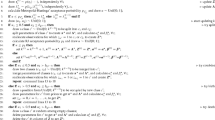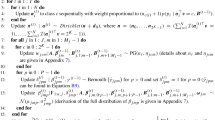Abstract
In a latent class IRT model in which the latent classes are ordered on one dimension, the class specific response probabilities are subject to inequality constraints. The number of these inequality constraints increase dramatically with the number of response categories per item, if assumptions like monotonicity or double monotonicity of the cumulative category response functions are postulated. A Markov chain Monte Carlo method, the Gibbs sampler, can sample from the multivariate posterior distribution of the parameters under the constraints. Bayesian model selection can be done by posterior predictive checks and Bayes factors. A simulation study is done to evaluate results of the application of these methods to ordered latent class models in three realistic situations. Also, an example of the presented methods is given for existing data with polytomous items. It can be concluded that the Bayesian estimation procedure can handle the inequality constraints on the parameters very well. However, the application of Bayesian model selection methods requires more research.
Similar content being viewed by others
References
Bartholomew, D.J., & Tzamourani, P. (1999). The goodness of fit of latent trait models in attitude measurement.Sociological Methods and Research, 27, 525–546.
Bayarri, M.J., & Berger, J.O. (2000).P values for composite null models.Journal of the American Statistical Association, 95, 1127–1142.
Cavalini, P.M. (1992).It's an ill wind that brings no good: Studies on odour annoyance and the dispersion of odorant concentrations from industries. Groningen: University Press Groningen.
Croon, M. (1990). Latent class analysis with ordered latent classes.British Journal of Mathematical and Statistical Psychology, 43, 171–192.
Croon, M.A. (1991). Investigating Mokken scalability of dichotomous items by means of ordinal latent class analysis.British Journal of Mathematical and Statistical Psychology, 44, 315–331.
Gelfand, A.E., Smith, A.F.M., & Lee, T.M. (1992). Bayesian analysis of constrained parameter and truncated data problems using Gibbs sampling.Journal of the American Statistical Association, 87, 523–532.
Gelman, A. (1996a). Inference and monitoring convergence. In W.R. Wilks, S. Richardson, & D.J. Spiegelhalter (Eds.),Markov Chain Monte Carlo in practice. Interdisciplinary statistics (pp. 131–143). London: Chapman & Hall.
Gelman, A. (1996b). Bayesian model-building by pure thought: Some principles and examples.Statistica Sinica, 6, 215–232.
Gelman, A., Carlin, J.B., Stern, H.S., & Rubin, D.B. (1995).Bayesian data analysis. London: Chapman & Hall.
Gelman, A., Meng, X.L., & Stern, H. (1996). Posterior predictive assessment of model fitness via realized discrepancies.Statistica Sinica, 6, 733–807.
Heinen, T. (1993).Discrete latent variable models. Tilburg: University Press.
Hemker, B.T., Sijtsma, K., Molenaar, I.W., & Junker, B.W. (1996). Polytomous IRT models and monotone likelihood ratio of the total score.Psychometrika, 61, 679–693.
Hemker, B.T., Sijtsma, K., Molenaar, I.W., & Junker, B.W. (1997). Stochastic ordering using the latent trait and the some score in polytomous IRT models.Psychometrika, 62, 331–347.
Hoijtink, H. (1998). Constrained latent class analysis using the Gibbs sampler and posterior predictivep-values: Applications to educational testing.Statistica Sinica, 8, 691–711.
Hoijtink, H., & Molenaar, I.W. (1997). A multidimensional item response model: Constrained latent class analysis using the Gibbs sampler and posterior predictive checks.Psychometrika, 62, 171–189.
Kass, R.E., & Raftery, A.E. (1995). Bayes factors.Journal of the American Statistical Association, 90, 773–795.
Meng, X.L. (1994). Posterior predictivep-values.The Annals of Statistics, 22, 1142–1160.
Mokken, R.J. (1971).A theory and procedure of scale analysis. The Hague: Mouton de Gruyter.
Molenaar, I.W., & Sijtsma, K. (2000).User's manual MSP5 for Windows. A program for Mokken scale analysis for polytomous items. Groningen: iec ProGAMMA.
Newton, M.A., & Raftery, A.E. (1994). Approximate Bayesian inference with the weighted likelihood bootstrap.Journal of the Royal Statistical Society, Series B, 56, 3–48.
Post, W. & Snijders, T.A.B. (1993). Nonparametric unfolding models for dichotomous data.Methodika, 7, 130–156.
Reiser, M., & Lin, Y. (1999). A goodness-of-fit test for the latent class model when expected frequencies are small.Sociological Methodology, 29, 81–111.
Robins, J.M., van der Vaart, A., Ventura, V. (2000). Asymptotic distributions ofP values in composite null models.Journal of the American Statistical Association, 95, 1143–1156.
Rubin, D.B., & Stern, H.S. (1994). Testing in latent class models using a posterior predictive check distribution. In A. von Eye, & C.C. Clogg (Eds.),Latent variables analysis. Applications for developmental research (pp. 420–438). Thousand Oaks: Sage.
Sijtsma, K. (1998). Methodology review: Nonparametric IRT approaches to the analysis of dichotomous item scores.Applied Psychological Measurement, 22, 3–31.
Sijtsma, K., & Hemker, B.T. (1998). Nonparametric polytomous IRT models for invariant item ordering, with results for parametric models.Psychometrika, 63, 183–200.
Stephens, M. (2000). Bayesian analysis of mixture models with an unknown number of components. An alternative to reversible jump methods.The Annals of Statistics, 28, 40–74.
Stout, W., Habing, B., Douglas, J., Kim, H.R., Roussos, L., & Zhang, J. (1996). Conditional covariance-based nonparametric multidimensionality assessment.Applied Psychological Measurement, 20, 331–354.
Tanner, M.A., & Wong, W.H. (1987). The calculation of posterior distributions by data augmentation.Journal of the American Statistical Association, 82, 528–540.
van Schuur, W.H. (1993). Nonparametric unidimensional unfolding for multicategory data,Political Analysis, 4, 41–74.
Vermunt, J.K. (1997).LEM: A general program for the analysis of categorical data. Tilburg: Tilburg University.
Vermunt, J.K. (1999). A general class of nonparametric models for ordinal categorical data.Sociological Methodology, 29, 187–223.
von Davier, M. (1997). Bootstrapping goodness-of-fit statistics for sparse categorical data—Results of a Monte Carlo study.Methods of Psychological Research Online, 2, 29–48.
Author information
Authors and Affiliations
Corresponding author
Additional information
This research was supported by the Netherlands Organization for Scientific Research (NWO), grant number 400-20-027. I would like to thank Ivo Molenaar, Herbert Hoijtink, Anne Boomsma, Marijtje van Duijn and the reviewers for their useful comments. I would also like to thank Sandra van Abswoude for her help with DETECT.
Rights and permissions
About this article
Cite this article
van Onna, M.J.H. Bayesian estimation and model selection in ordered latent class models for polytomous items. Psychometrika 67, 519–538 (2002). https://doi.org/10.1007/BF02295129
Received:
Revised:
Issue Date:
DOI: https://doi.org/10.1007/BF02295129




